Abstract
We have previously characterized with monoclonal antibodies (MAbs) seven unique epitopes on the two envelope glycoproteins of Venezuelan equine encephalomyelitis (VEE) virus vaccine strain TC-83. The epitopes important in protection from VEE virus infection were determined in passive antibody transfer studies, with virulent VEE (Trinidad donkey) virus as the challenge virus. Selected high-avidity MAbs to the three major protective epitopes (E2c, E1b, and E1d) were assayed for in vitro complement activity. All three fixed murine complement to high titer. Limited pepsin digestion of the anti-E2c in the presence of cysteine resulted in a rapid decrease and complete loss of complement-fixing ability by 2 h, but the majority of mice, except at the lowest dilution of MAb, were protected until the Fc termini were cleaved at 3 h. Anti-E2c F(ab')2 would neutralize VEE (Trinidad donkey) virus more efficiently than either Fab' or Fab; none of the fragments would fix complement or was effective in passive protection. C5-deficient mice and mice depleted of C3 with cobra venom factor were still protected from VEE (Trinidad donkey) virus challenge after passive transfer of either anti-E2c or anti-E1b MAb. The results show that the anti-E2c MAb mediates neutralization through bivalent binding at a critical site on the virion and that Fc effector functions, other than complement, are necessary for protection. Although the ability of the anti-E2c MAb to fix complement was associated with its ability to protect in vivo, no direct cause-and-effect relationship was found. Since the epitope defined by the anti-E1d antibody is found on the cell membrane, but is not expressed on the infectious virion, protection in mice was most likely mediated at the cellular level, possibly by inhibition of the final stages of virion maturation.
Full text
PDF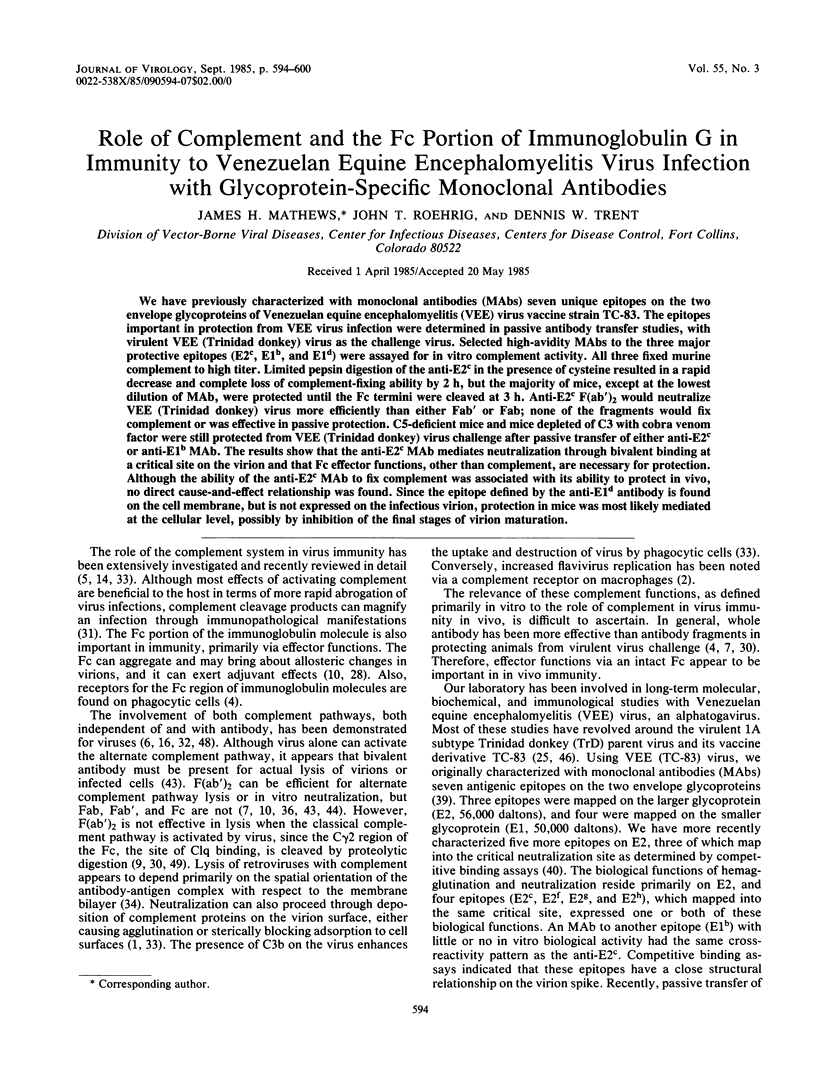

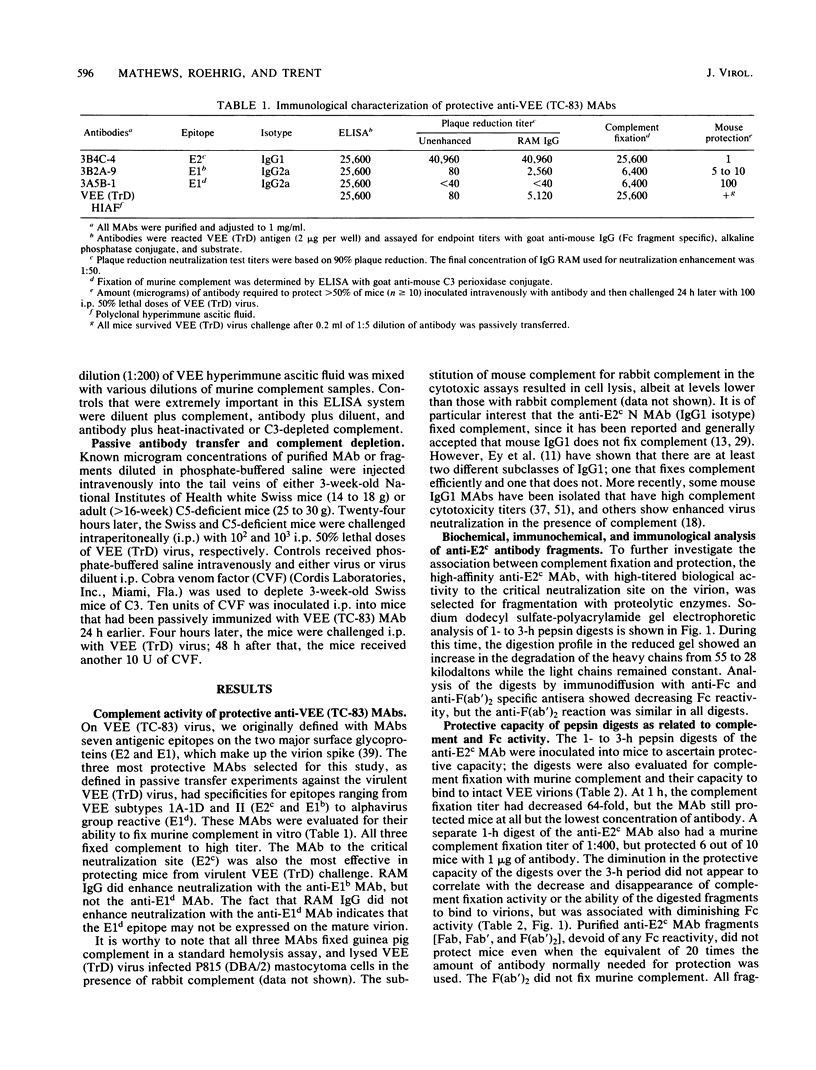
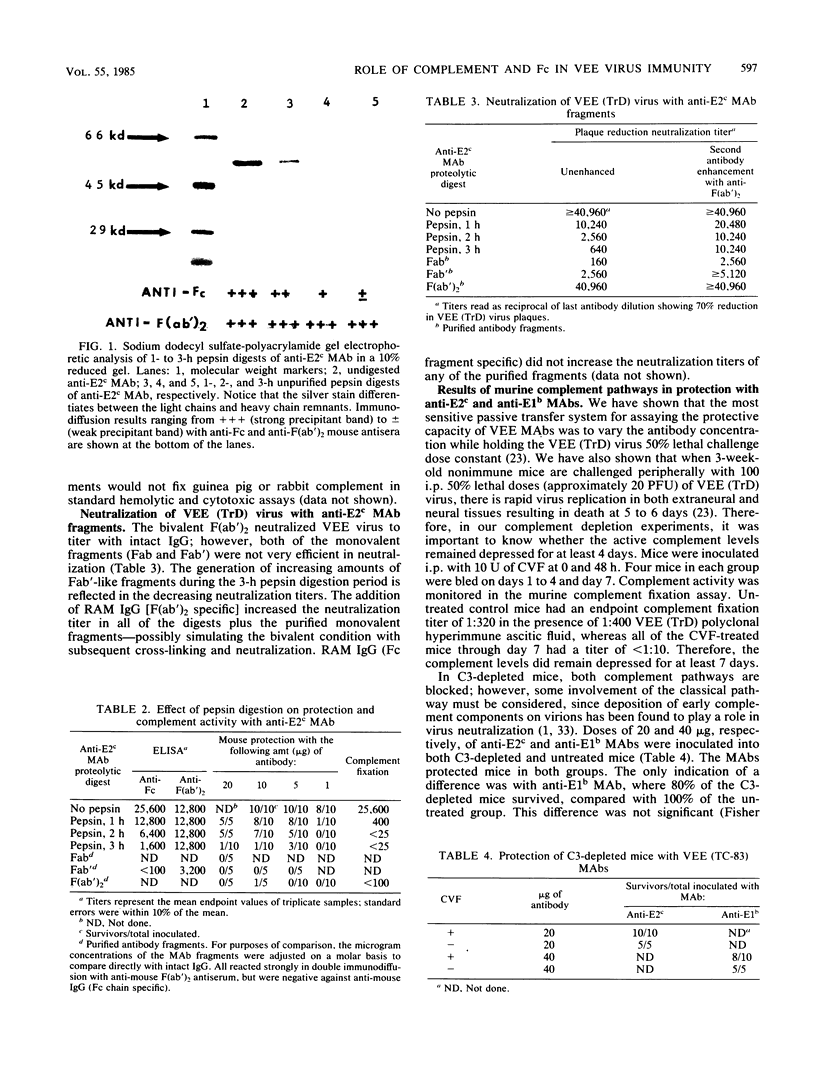
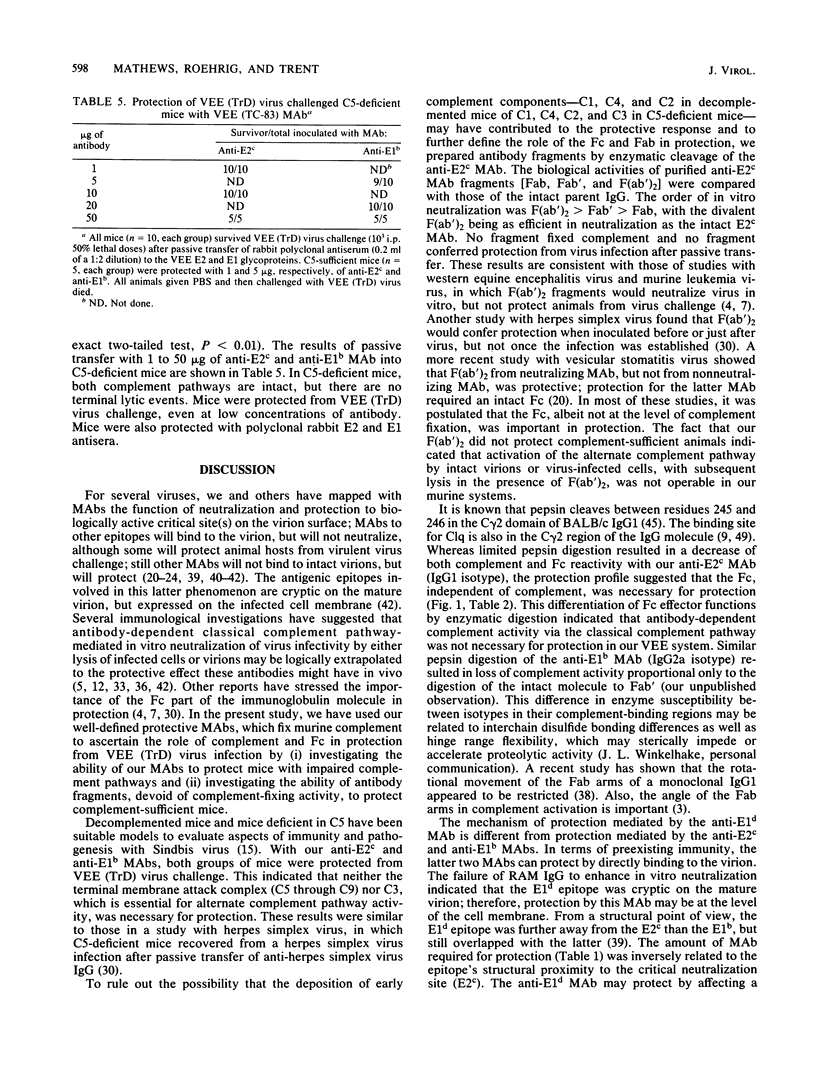

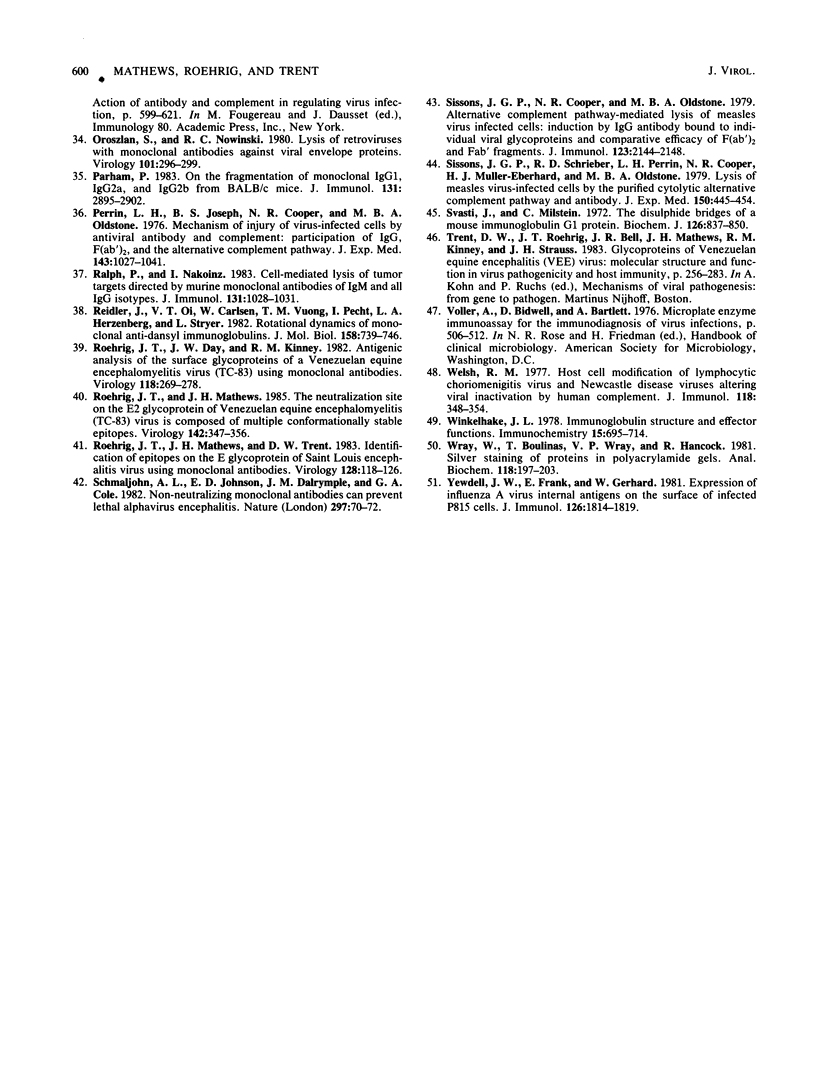
Images in this article
Selected References
These references are in PubMed. This may not be the complete list of references from this article.
- Beebe D. P., Schreiber R. D., Cooper N. R. Neutralization of influenza virus by normal human sera: mechanisms involving antibody and complement. J Immunol. 1983 Mar;130(3):1317–1322. [PubMed] [Google Scholar]
- Cardosa M. J., Porterfield J. S., Gordon S. Complement receptor mediates enhanced flavivirus replication in macrophages. J Exp Med. 1983 Jul 1;158(1):258–263. doi: 10.1084/jem.158.1.258. [DOI] [PMC free article] [PubMed] [Google Scholar]
- Circolo A., Borsos T. Lysis of hapten-labeled cells by anti-hapten IgG and complement: effect of cell surface hapten density. J Immunol. 1982 Mar;128(3):1118–1121. [PubMed] [Google Scholar]
- Collins J. J., Sackie D. M., Johnson G. R. Immunotherapy of murine leukemia. IX. The requirement for the Fc portion of antibody for successful passive serum therapy of Friend leukemia virus-induced disease. Virology. 1983 Apr 15;126(1):259–266. doi: 10.1016/0042-6822(83)90477-4. [DOI] [PubMed] [Google Scholar]
- Cooper N. R., Jensen F. C., Welsh R. M., Jr, Oldstone M. B. Lysis of RNA tumor viruses by human serum: direct antibody-independent triggering of the classical complement pathway. J Exp Med. 1976 Oct 1;144(4):970–984. doi: 10.1084/jem.144.4.970. [DOI] [PMC free article] [PubMed] [Google Scholar]
- Cremer N. E., Riggs J. L., Lennette E. H. Neutralization kinetics of western equine encephalitis virus by antibody fragments. Immunochemistry. 1975 Jul;12(6-7):597–601. doi: 10.1016/0019-2791(75)90092-0. [DOI] [PubMed] [Google Scholar]
- Dissanayake S., Hay F. C. Pepsin digestion of mouse IgG immunoglobulins subfragments of the Fc region. Immunochemistry. 1975 May;12(5):373–378. doi: 10.1016/0019-2791(75)90003-8. [DOI] [PubMed] [Google Scholar]
- Dorrington K. J. The structural basis for the functional versatility of immunoglobulin G1. Can J Biochem. 1978 Dec;56(12):1087–1101. doi: 10.1139/o78-172. [DOI] [PubMed] [Google Scholar]
- Emini E. A., Ostapchuk P., Wimmer E. Bivalent attachment of antibody onto poliovirus leads to conformational alteration and neutralization. J Virol. 1983 Nov;48(2):547–550. doi: 10.1128/jvi.48.2.547-550.1983. [DOI] [PMC free article] [PubMed] [Google Scholar]
- Ey P. L., Prowse S. J., Jenkin C. R. Complement-fixing IgG1 constitutes a new subclass of mouse IgG. Nature. 1979 Oct 11;281(5731):492–493. doi: 10.1038/281492a0. [DOI] [PubMed] [Google Scholar]
- Grant C. K., Ernisse B. J., Jarrett O., Jones F. R. Feline leukemia virus envelope gp70 of subgroups B and C defined by monoclonal antibodies with cytotoxic and neutralizing functions. J Immunol. 1983 Dec;131(6):3042–3048. [PubMed] [Google Scholar]
- Hirsch R. L., Griffin D. E., Winkelstein J. A. Role of complement in viral infections: participation of terminal complement components (C5 to C9) in recovery of mice from Sindbis virus infection. Infect Immun. 1980 Dec;30(3):899–901. doi: 10.1128/iai.30.3.899-901.1980. [DOI] [PMC free article] [PubMed] [Google Scholar]
- Hirsch R. L. The complement system: its importance in the host response to viral infection. Microbiol Rev. 1982 Mar;46(1):71–85. doi: 10.1128/mr.46.1.71-85.1982. [DOI] [PMC free article] [PubMed] [Google Scholar]
- Hirsch R. L., Winkelstein J. A., Griffin D. E. The role of complement in viral infections. III. Activation of the classical and alternative complement pathways by Sindbis virus. J Immunol. 1980 May;124(5):2507–2510. [PubMed] [Google Scholar]
- Hunt A. R., Roehrig J. T. Biochemical and biological characteristics of epitopes on the E1 glycoprotein of western equine encephalitis virus. Virology. 1985 Apr 30;142(2):334–346. doi: 10.1016/0042-6822(85)90342-3. [DOI] [PubMed] [Google Scholar]
- Keller P. M., Neff B. J., Ellis R. W. Three major glycoprotein genes of varicella-zoster virus whose products have neutralization epitopes. J Virol. 1984 Oct;52(1):293–297. doi: 10.1128/jvi.52.1.293-297.1984. [DOI] [PMC free article] [PubMed] [Google Scholar]
- Laemmli U. K. Cleavage of structural proteins during the assembly of the head of bacteriophage T4. Nature. 1970 Aug 15;227(5259):680–685. doi: 10.1038/227680a0. [DOI] [PubMed] [Google Scholar]
- Lefrancois L. Protection against lethal viral infection by neutralizing and nonneutralizing monoclonal antibodies: distinct mechanisms of action in vivo. J Virol. 1984 Jul;51(1):208–214. doi: 10.1128/jvi.51.1.208-214.1984. [DOI] [PMC free article] [PubMed] [Google Scholar]
- Lubeck M., Gerhard W. Conformational changes at topologically distinct antigenic sites on the influenza A/PR/8/34 virus HA molecule are induced by the binding of monoclonal antibodies. Virology. 1982 Apr 15;118(1):1–7. doi: 10.1016/0042-6822(82)90313-0. [DOI] [PubMed] [Google Scholar]
- Massey R. J., Schochetman G. Topographical analysis of viral epitopes using monoclonal antibodies: mechanism of virus neutralization. Virology. 1981 Nov;115(1):20–32. doi: 10.1016/0042-6822(81)90085-4. [DOI] [PubMed] [Google Scholar]
- Mathews J. H., Roehrig J. T. Determination of the protective epitopes on the glycoproteins of Venezuelan equine encephalomyelitis virus by passive transfer of monoclonal antibodies. J Immunol. 1982 Dec;129(6):2763–2767. [PubMed] [Google Scholar]
- Mathews J. H., Roehrig J. T. Elucidation of the topography and determination of the protective epitopes on the E glycoprotein of Saint Louis encephalitis virus by passive transfer with monoclonal antibodies. J Immunol. 1984 Mar;132(3):1533–1537. [PubMed] [Google Scholar]
- Mecham J. O., Trent D. W. A biochemical comparison of the in vitro replication of a virulent and an avirulent strain of Venezuelan encephalitis virus. J Gen Virol. 1983 May;64(Pt 5):1111–1119. doi: 10.1099/0022-1317-64-5-1111. [DOI] [PubMed] [Google Scholar]
- Morgan E. L., Walker S. M., Thoman M. L., Weigle W. O. Regulation of the immune response. I. The potentiation of in vivo and in vitro immune responses by Fc fragments. J Exp Med. 1980 Jul 1;152(1):113–123. doi: 10.1084/jem.152.1.113. [DOI] [PMC free article] [PubMed] [Google Scholar]
- NUSSENZWEIG R. S., MERRYMAN C., BENACERRAF B. ELECTROPHORETIC SEPARATION AND PROPERTIES OF MOUSE ANTIHAPTEN ANTIBODIES INVOLVED IN PASSIVE CUTANEOUS ANAPHYLAXIS AND PASSIVE HEMOLYSIS. J Exp Med. 1964 Aug 1;120:315–328. doi: 10.1084/jem.120.2.315. [DOI] [PMC free article] [PubMed] [Google Scholar]
- Oakes J. E., Lausch R. N. Role of Fc fragments in antibody-mediated recovery from ocular and subcutaneous herpes simplex virus infections. Infect Immun. 1981 Jul;33(1):109–114. doi: 10.1128/iai.33.1.109-114.1981. [DOI] [PMC free article] [PubMed] [Google Scholar]
- Oldstone M. B., Dixon F. J. Acute viral infection: tissue injury mediated by anti-viral antibody through a complement effector system. J Immunol. 1971 Nov;107(5):1274–1280. [PubMed] [Google Scholar]
- Oroszlan S., Nowinski R. C. Lysis of retroviruses with monoclonal antibodies against viral envelope proteins. Virology. 1980 Feb;101(1):296–299. doi: 10.1016/0042-6822(80)90507-3. [DOI] [PubMed] [Google Scholar]
- Parham P. On the fragmentation of monoclonal IgG1, IgG2a, and IgG2b from BALB/c mice. J Immunol. 1983 Dec;131(6):2895–2902. [PubMed] [Google Scholar]
- Patrick Sissons J. G., Schreiber R. D., Perrin L. H., Cooper N. R., Müller-Eberhard H. J., Oldstone M. B. Lysis of measles virus-infected cells by the purified cytolytic alternative complement pathway and antibody. J Exp Med. 1979 Sep 19;150(3):445–454. doi: 10.1084/jem.150.3.445. [DOI] [PMC free article] [PubMed] [Google Scholar]
- Perrin L. H., Joseph B. S., Cooper N. R., Oldstone M. B. Mechanism of injury of virus-infected cells by antiviral antibody and complement: participation of IgG, F(ab')2, and the alternative complement pathway. J Exp Med. 1976 May 1;143(5):1027–1041. doi: 10.1084/jem.143.5.1027. [DOI] [PMC free article] [PubMed] [Google Scholar]
- Ralph P., Nakoinz I. Cell-mediated lysis of tumor targets directed by murine monoclonal antibodies of IgM and all IgG isotypes. J Immunol. 1983 Aug;131(2):1028–1031. [PubMed] [Google Scholar]
- Reidler J., Oi V. T., Carlsen W., Vuong T. M., Pecht I., Herzenberg L. A., Stryer L. Rotational dynamics of monoclonal anti-dansyl immunoglobulins. J Mol Biol. 1982 Jul 15;158(4):739–746. doi: 10.1016/0022-2836(82)90258-3. [DOI] [PubMed] [Google Scholar]
- Roehrig J. T., Day J. W., Kinney R. M. Antigenic analysis of the surface glycoproteins of a Venezuelan equine encephalomyelitis virus (TC-83) using monoclonal antibodies. Virology. 1982 Apr 30;118(2):269–278. doi: 10.1016/0042-6822(82)90346-4. [DOI] [PubMed] [Google Scholar]
- Roehrig J. T., Mathews J. H. The neutralization site on the E2 glycoprotein of Venezuelan equine encephalomyelitis (TC-83) virus is composed of multiple conformationally stable epitopes. Virology. 1985 Apr 30;142(2):347–356. doi: 10.1016/0042-6822(85)90343-5. [DOI] [PubMed] [Google Scholar]
- Roehrig J. T., Mathews J. H., Trent D. W. Identification of epitopes on the E glycoprotein of Saint Louis encephalitis virus using monoclonal antibodies. Virology. 1983 Jul 15;128(1):118–126. doi: 10.1016/0042-6822(83)90323-9. [DOI] [PubMed] [Google Scholar]
- Schmaljohn A. L., Johnson E. D., Dalrymple J. M., Cole G. A. Non-neutralizing monoclonal antibodies can prevent lethal alphavirus encephalitis. Nature. 1982 May 6;297(5861):70–72. doi: 10.1038/297070a0. [DOI] [PubMed] [Google Scholar]
- Sissons J. G., Cooper N. R., Oldstone M. B. Alternative complement pathway-mediated lysis of measles virus infected cells: induction by IgG antibody bound to individual viral glycoproteins and comparative efficacy of F(ab')2 and Fab' fragments. J Immunol. 1979 Nov;123(5):2144–2149. [PubMed] [Google Scholar]
- Svasti J., Milstein C. The disulphide bridges of a mouse immunoglobulin G1 protein. Biochem J. 1972 Feb;126(4):837–850. doi: 10.1042/bj1260837. [DOI] [PMC free article] [PubMed] [Google Scholar]
- Welsh R. M. Host cell modification of lymphocytic choriomeningitis virus and Newcastle disease virus altering viral inactivation by human complement. J Immunol. 1977 Jan;118(1):348–354. [PubMed] [Google Scholar]
- Winkelhake J. L. Immunoglobulin structure and effector functions. Immunochemistry. 1978 Sep;15(9):695–714. doi: 10.1016/0161-5890(78)90044-5. [DOI] [PubMed] [Google Scholar]
- Wray W., Boulikas T., Wray V. P., Hancock R. Silver staining of proteins in polyacrylamide gels. Anal Biochem. 1981 Nov 15;118(1):197–203. doi: 10.1016/0003-2697(81)90179-2. [DOI] [PubMed] [Google Scholar]
- Yewdell J. W., Frank E., Gerhard W. Expression of influenza A virus internal antigens on the surface of infected P815 cells. J Immunol. 1981 May;126(5):1814–1819. [PubMed] [Google Scholar]



